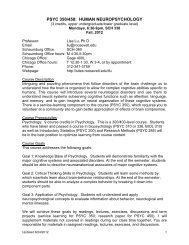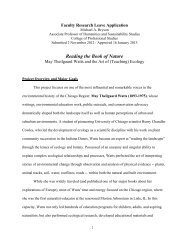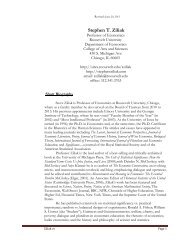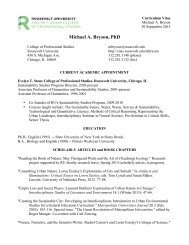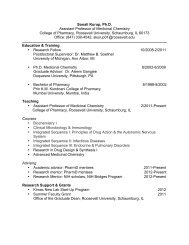Mothering Violence: Ferocious Female Resistance in Toni ...
Mothering Violence: Ferocious Female Resistance in Toni ...
Mothering Violence: Ferocious Female Resistance in Toni ...
Create successful ePaper yourself
Turn your PDF publications into a flip-book with our unique Google optimized e-Paper software.
fall 2011 / black women, gender, and families 27<br />
children (and subsequently adults) who feel detached from others <strong>in</strong> their<br />
community, allow<strong>in</strong>g the twisted familial violence to be perpetuated. Home,<br />
then, becomes a place to learn pa<strong>in</strong>, while community becomes a place to<br />
act it out.<br />
F<strong>in</strong>ally, Morrison establishes child murder as the ultimate form of mother<br />
violence, expos<strong>in</strong>g the complexities of the mother<strong>in</strong>g construct <strong>in</strong> terms of<br />
creation and destruction. By not only decid<strong>in</strong>g on death for their progeny<br />
but also perform<strong>in</strong>g the murder themselves, these black women assert their<br />
motherhood over societal mores. By choos<strong>in</strong>g death for their children, these<br />
mothers claim their motherhood <strong>in</strong> ways that are challeng<strong>in</strong>g to understand—yet,<br />
<strong>in</strong> do<strong>in</strong>g so, these female characters achieve astonish<strong>in</strong>gly powerful<br />
personas.<br />
In The Bluest Eye, n<strong>in</strong>e-year-old Claudia beg<strong>in</strong>s to discover the need<br />
for rebellion when she encounters her <strong>in</strong>visibility <strong>in</strong> popular culture. Her<br />
hatred of white baby dolls beg<strong>in</strong>s with an aversion to a famous white child<br />
star. With an adult-like understand<strong>in</strong>g of the <strong>in</strong>equities that occur daily due<br />
to sk<strong>in</strong> color, Claudia shares her dislike of Shirley Temple, who danced with<br />
Bill “Bojangles” Rob<strong>in</strong>son, a famous black tap dancer, <strong>in</strong> various films: “I<br />
couldn’t jo<strong>in</strong> [Freda and Pecola] <strong>in</strong> their adoration because I hated Shirley.<br />
Not because she was cute, but because she danced with Bojangles, who was my<br />
friend, my uncle, my daddy, and who ought to have been soft-shoe<strong>in</strong>g it and<br />
chuckl<strong>in</strong>g with me” 1 (Morrison 1994, 19). In Claudia’s explanation, it’s clear<br />
that she feels someth<strong>in</strong>g has been stolen from her (and others like her)—and<br />
given to the white child star <strong>in</strong>stead. The performance pair<strong>in</strong>g of the adult<br />
black male and the small white girl highlights the absence of the small black<br />
girl performer—the performer who looked like Claudia. Instead of shar<strong>in</strong>g<br />
the spotlight, the black girl becomes <strong>in</strong>visible, and Claudia’s feel<strong>in</strong>gs of<br />
anger due to that <strong>in</strong>visibility are projected onto Shirley Temple: someone<br />
out of reach and yet with<strong>in</strong> view. Claudia’s feel<strong>in</strong>gs of black <strong>in</strong>visibility are<br />
magnified via the white baby dolls she receives as gifts. By dismember<strong>in</strong>g<br />
them, Claudia disrupts the obsessive desire to worship white/light attributes,<br />
reject<strong>in</strong>g them for her own blackness. She rebels aga<strong>in</strong>st white oppression,<br />
forc<strong>in</strong>g others to see her and not a reflection of whiteness.<br />
The outward violence Claudia feels is not unlike the heartbreak<strong>in</strong>g <strong>in</strong>ternal<br />
violence another black girl <strong>in</strong> The Bluest Eye, Pecola, demonstrates aga<strong>in</strong>st<br />
herself for similar reasons. Despised by her mother and ignored by her father,<br />
Pecola is a tragic example of the destructive power of accept<strong>in</strong>g white beauty<br />
standards. Realiz<strong>in</strong>g that the “white immigrant storekeeper” who she is buy<strong>in</strong>g<br />
candy from, shows only “distaste . . . for her, her blackness” (ibid., 48–49),



